Page 204 of 474
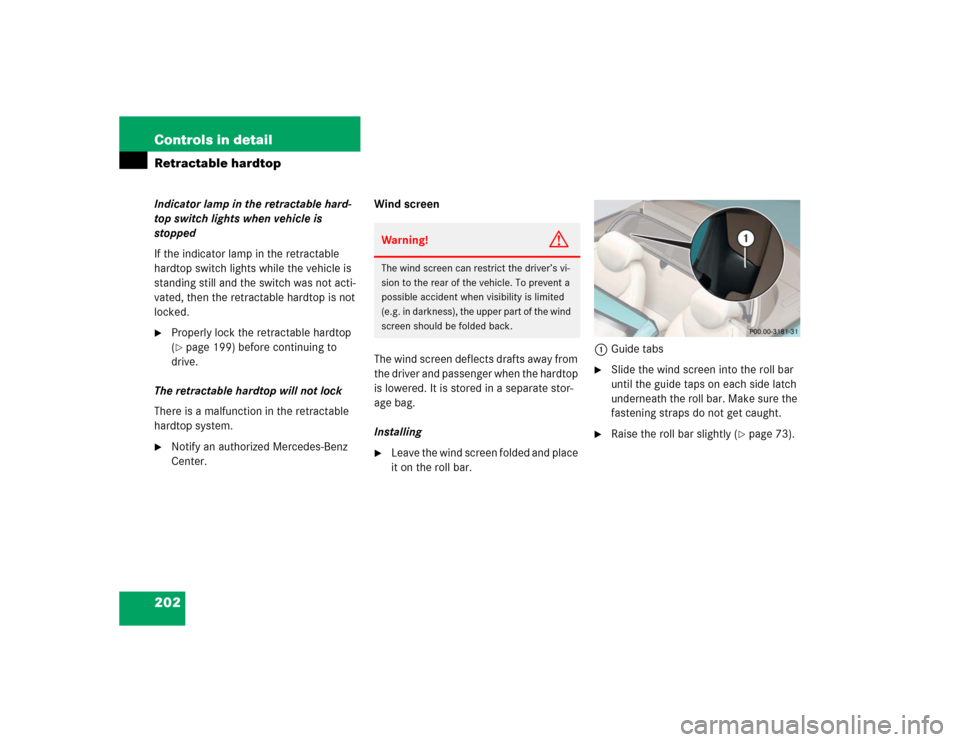
202 Controls in detailRetractable hardtopIndicator lamp in the retractable hard-
top switch lights when vehicle is
stopped
If the indicator lamp in the retractable
hardtop switch lights while the vehicle is
standing still and the switch was not acti-
vated, then the retractable hardtop is not
locked.�
Properly lock the retractable hardtop
(�page 199) before continuing to
drive.
The retractable hardtop will not lock
There is a malfunction in the retractable
hardtop system.
�
Notify an authorized Mercedes-Benz
Center.Wind screen
The wind screen deflects drafts away from
the driver and passenger when the hardtop
is lowered. It is stored in a separate stor-
age bag.
Installing
�
Leave the wind screen folded and place
it on the roll bar.1Guide tabs
�
Slide the wind screen into the roll bar
until the guide taps on each side latch
underneath the roll bar. Make sure the
fastening straps do not get caught.
�
Raise the roll bar slightly (
�page 73).
Warning!
G
The wind screen can restrict the driver’s vi-
sion to the rear of the vehicle. To prevent a
possible accident when visibility is limited
(e.g. in darkness), the upper part of the wind
screen should be folded back.
Page 205 of 474
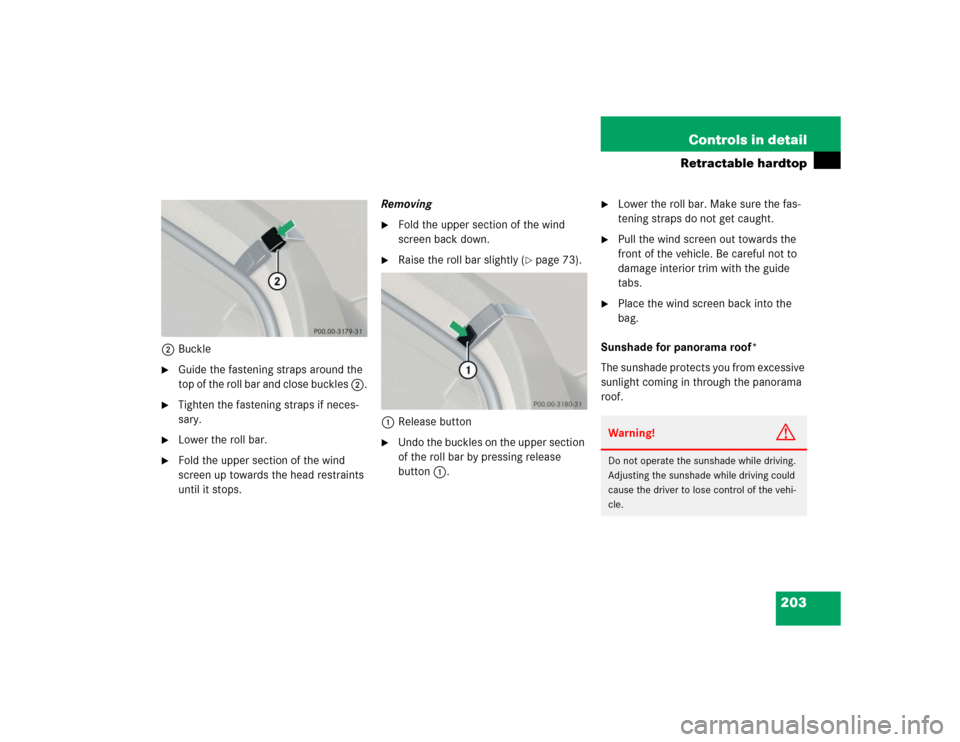
203 Controls in detail
Retractable hardtop
2Buckle�
Guide the fastening straps around the
top of the roll bar and close buckles 2.
�
Tighten the fastening straps if neces-
sary.
�
Lower the roll bar.
�
Fold the upper section of the wind
screen up towards the head restraints
until it stops.Removing
�
Fold the upper section of the wind
screen back down.
�
Raise the roll bar slightly (
�page 73).
1Release button
�
Undo the buckles on the upper section
of the roll bar by pressing release
button1.
�
Lower the roll bar. Make sure the fas-
tening straps do not get caught.
�
Pull the wind screen out towards the
front of the vehicle. Be careful not to
damage interior trim with the guide
tabs.
�
Place the wind screen back into the
bag.
Sunshade for panorama roof*
The sunshade protects you from excessive
sunlight coming in through the panorama
roof.Warning!
G
Do not operate the sunshade while driving.
Adjusting the sunshade while driving could
cause the driver to lose control of the vehi-
cle.
Page 207 of 474
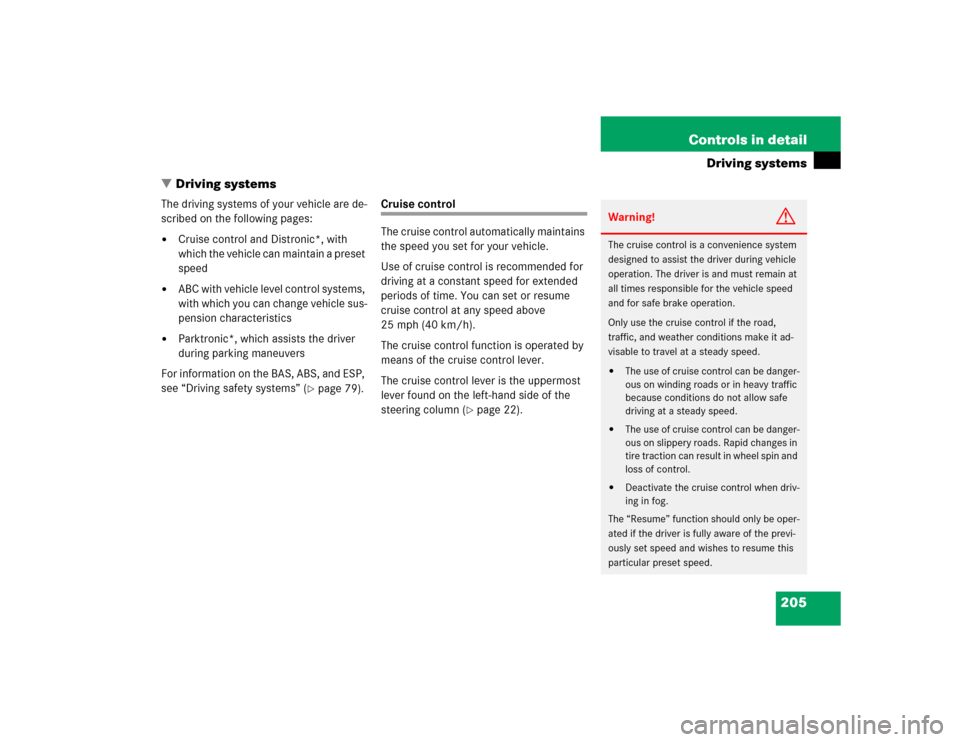
205 Controls in detail
Driving systems
�Driving systems
The driving systems of your vehicle are de-
scribed on the following pages:�
Cruise control and Distronic*, with
which the vehicle can maintain a preset
speed
�
ABC with vehicle level control systems,
with which you can change vehicle sus-
pension characteristics
�
Parktronic*, which assists the driver
during parking maneuvers
For information on the BAS, ABS, and ESP,
see “Driving safety systems” (
�page 79).
Cruise control
The cruise control automatically maintains
the speed you set for your vehicle.
Use of cruise control is recommended for
driving at a constant speed for extended
periods of time. You can set or resume
cruise control at any speed above
25 mph (40 km/h).
The cruise control function is operated by
means of the cruise control lever.
The cruise control lever is the uppermost
lever found on the left-hand side of the
steering column (
�page 22).
Warning!
G
The cruise control is a convenience system
designed to assist the driver during vehicle
operation. The driver is and must remain at
all times responsible for the vehicle speed
and for safe brake operation.
Only use the cruise control if the road,
traffic, and weather conditions make it ad-
visable to travel at a steady speed.�
The use of cruise control can be danger-
ous on winding roads or in heavy traffic
because conditions do not allow safe
driving at a steady speed.
�
The use of cruise control can be danger-
ous on slippery roads. Rapid changes in
tire traction can result in wheel spin and
loss of control.
�
Deactivate the cruise control when driv-
ing in fog.
The “Resume” function should only be oper-
ated if the driver is fully aware of the previ-
ously set speed and wishes to resume this
particular preset speed.
Page 264 of 474
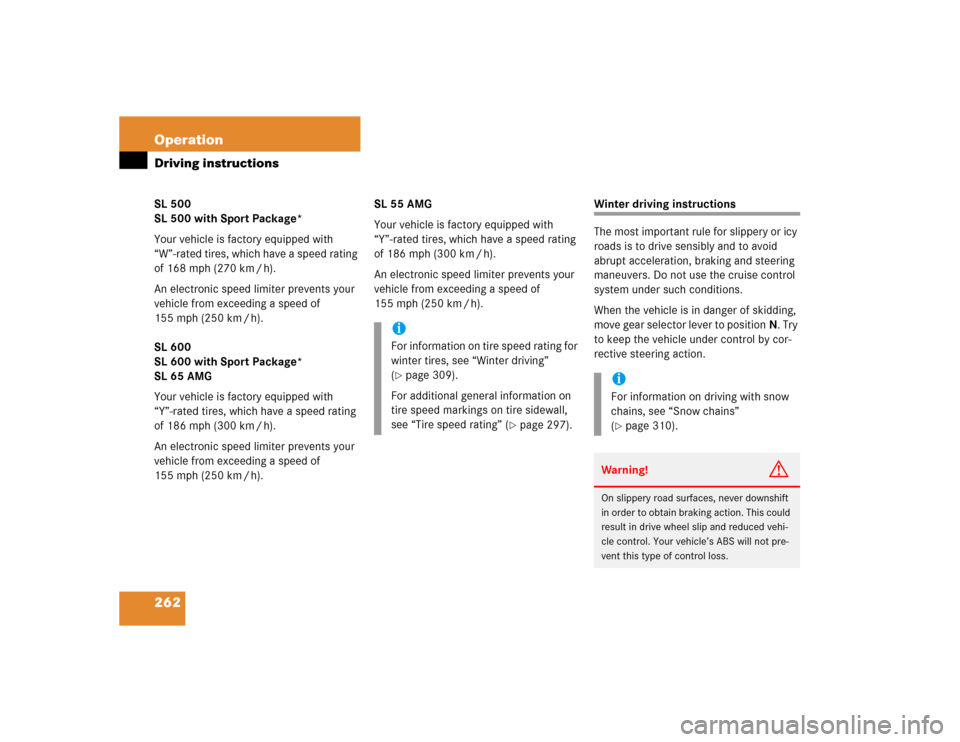
262 OperationDriving instructionsSL 500
SL 500 with Sport Package*
Your vehicle is factory equipped with
“W”-rated tires, which have a speed rating
of 168 mph (270 km / h).
An electronic speed limiter prevents your
vehicle from exceeding a speed of
155 mph (250 km / h).
SL 600
SL 600 with Sport Package*
SL 65 AMG
Your vehicle is factory equipped with
“Y”-rated tires, which have a speed rating
of 186 mph (300 km / h).
An electronic speed limiter prevents your
vehicle from exceeding a speed of
155 mph (250 km / h).SL 55 AMG
Your vehicle is factory equipped with
“Y”-rated tires, which have a speed rating
of 186 mph (300 km / h).
An electronic speed limiter prevents your
vehicle from exceeding a speed of
155 mph (250 km / h).
Winter driving instructions
The most important rule for slippery or icy
roads is to drive sensibly and to avoid
abrupt acceleration, braking and steering
maneuvers. Do not use the cruise control
system under such conditions.
When the vehicle is in danger of skidding,
move gear selector lever to positionN. Try
to keep the vehicle under control by cor-
rective steering action.
iFor information on tire speed rating for
winter tires, see “Winter driving”
(�page 309).
For additional general information on
tire speed markings on tire sidewall,
see “Tire speed rating” (
�page 297).
iFor information on driving with snow
chains, see “Snow chains”
(�page 310).
Warning!
G
On slippery road surfaces, never downshift
in order to obtain braking action. This could
result in drive wheel slip and reduced vehi-
cle control. Your vehicle’s ABS will not pre-
vent this type of control loss.
Page 301 of 474
299 Operation
Tires and wheels
All-season and winter tires
Load identification
1Load identificationIn addition to tire load rating, special load
information may be molded into the tire
sidewall following the letter designating
the tire speed rating1 (
�page 299).
No specification given: absence of any text
(like in above example) indicates a
standard load (SL) tire.
XL or Extra Load: designates an extra load
(or reinforced) tire.
Light Load: designates a light load tire.
C, D, E: designates load range associated
with the maximum load a tire can carry at
a specified pressure.
Index
Speed rating
QM+S
up to 100 mph (160 km/h)
TM+S
up to 118 mph (190 km/h)
HM+S
up to 130 mph (210 km/h)
VM+S
up to 149 mph (240 km/h)
iThe marking “M+S” next to the service
description designates tires with mud
and snow capabilities.
iFor illustration purposes only. Actual
data on tires is specific to each vehicle
and may vary from data shown in above
illustration.
Page 311 of 474
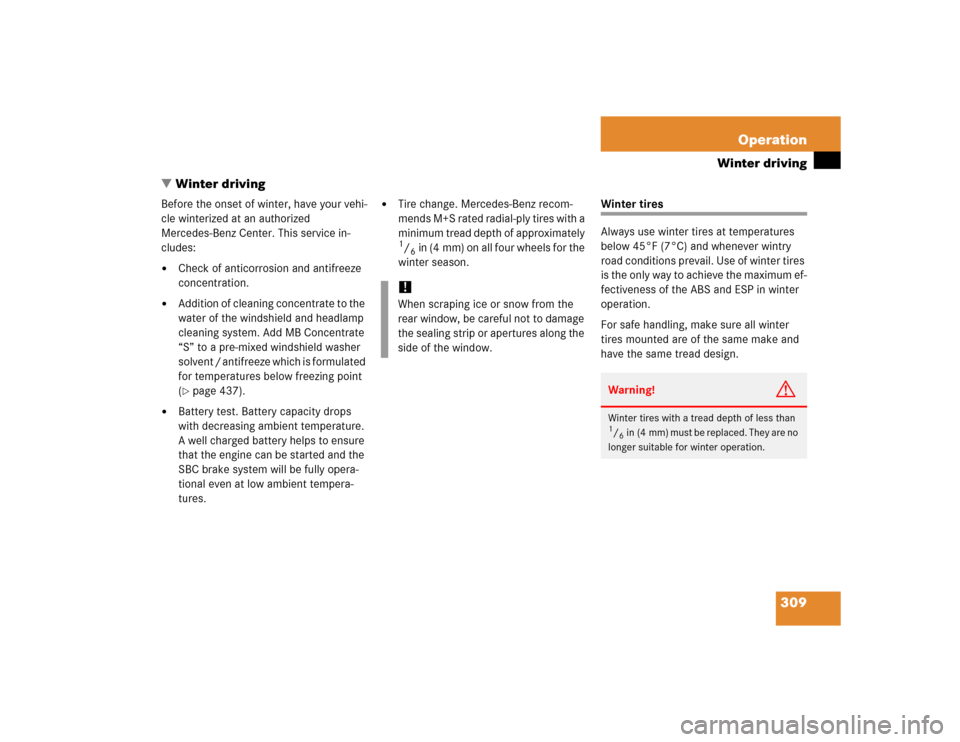
309 Operation
Winter driving
�Winter driving
Before the onset of winter, have your vehi-
cle winterized at an authorized
Mercedes-Benz Center. This service in-
cludes:�
Check of anticorrosion and antifreeze
concentration.
�
Addition of cleaning concentrate to the
water of the windshield and headlamp
cleaning system. Add MB Concentrate
“S” to a pre-mixed windshield washer
solvent / antifreeze which is formulated
for temperatures below freezing point
(�page 437).
�
Battery test. Battery capacity drops
with decreasing ambient temperature.
A well charged battery helps to ensure
that the engine can be started and the
SBC brake system will be fully opera-
tional even at low ambient tempera-
tures.
�
Tire change. Mercedes-Benz recom-
mends M+S rated radial-ply tires with a
minimum tread depth of approximately 1/6in (4 mm) on all four wheels for the
winter season.
Winter tires
Always use winter tires at temperatures
below 45°F (7°C) and whenever wintry
road conditions prevail. Use of winter tires
is the only way to achieve the maximum ef-
fectiveness of the ABS and ESP in winter
operation.
For safe handling, make sure all winter
tires mounted are of the same make and
have the same tread design.
!When scraping ice or snow from the
rear window, be careful not to damage
the sealing strip or apertures along the
side of the window.
Warning!
G
Winter tires with a tread depth of less than 1/6in (4 mm) must be replaced. They are no
longer suitable for winter operation.
Page 326 of 474
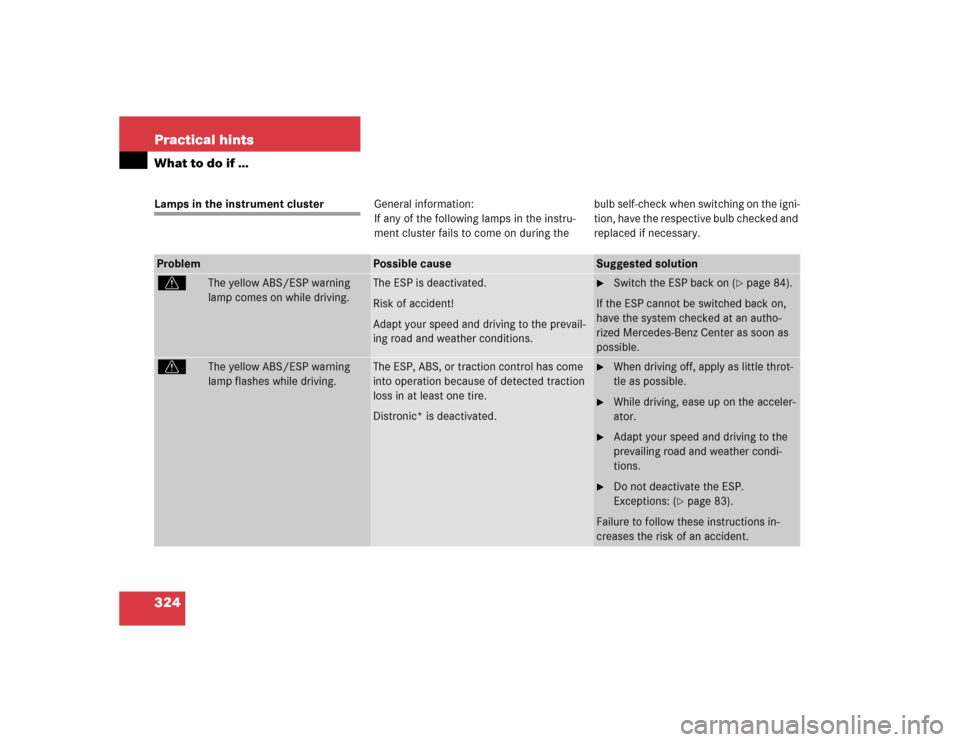
324 Practical hintsWhat to do if …Lamps in the instrument clusterGeneral information:
If any of the following lamps in the instru-
ment cluster fails to come on during thebulb self-check when switching on the igni-
tion, have the respective bulb checked and
replaced if necessary.Problem
Possible cause
Suggested solution
v
The yellow ABS/ESP warning
lamp comes on while driving.
The ESP is deactivated.
Risk of accident!
Adapt your speed and driving to the prevail-
ing road and weather conditions.
�
Switch the ESP back on (
�page 84).
If the ESP cannot be switched back on,
have the system checked at an autho-
rized Mercedes-Benz Center as soon as
possible.
v
The yellow ABS/ESP warning
lamp flashes while driving.
The ESP, ABS, or traction control has come
into operation because of detected traction
loss in at least one tire.
Distronic* is deactivated.
�
When driving off, apply as little throt-
tle as possible.
�
While driving, ease up on the acceler-
ator.
�
Adapt your speed and driving to the
prevailing road and weather condi-
tions.
�
Do not deactivate the ESP.
Exceptions: (
�page 83).
Failure to follow these instructions in-
creases the risk of an accident.
Page 327 of 474

325 Practical hints
What to do if …
Problem
Possible cause
Suggested solution
-
The yellow ABS indicator lamp
comes on while driving.
The ABS has detected a malfunction and has
switched off. The BAS and the ESP are also
switched off (see messages in display).
The SBC brake system is still functioning nor-
mally but without ABS available.
If the ABS control unit is malfunctioning, oth-
er systems such as Parktronic*, Distronic*,
or the automatic transmission may also be
malfunctioning.
�
Continue driving with added caution.
Wheels may lock during hard braking,
reducing steering capability.
�
Have the system checked at an autho-
rized Mercedes-Benz Center as soon
as possible.
Failure to follow these instructions in-
creases the risk of an accident.
�
Read and observe messages in the
display (
�page 335).
The charging voltage has fallen below
10 volts and the ABS was switched off.
The battery may not be sufficiently charged.
�
Switch off electrical consumers that
are currently not needed, e.g. seat
heating.
�
If necessary, have the generator and
battery checked.
When the voltage is above this value
again, the ABS is operational again.